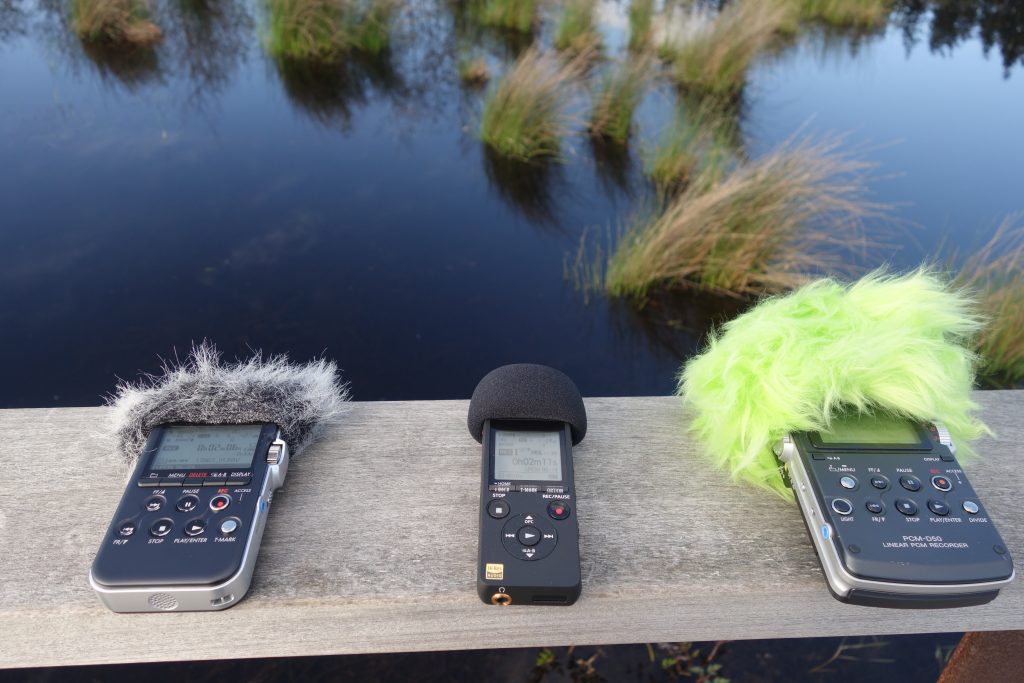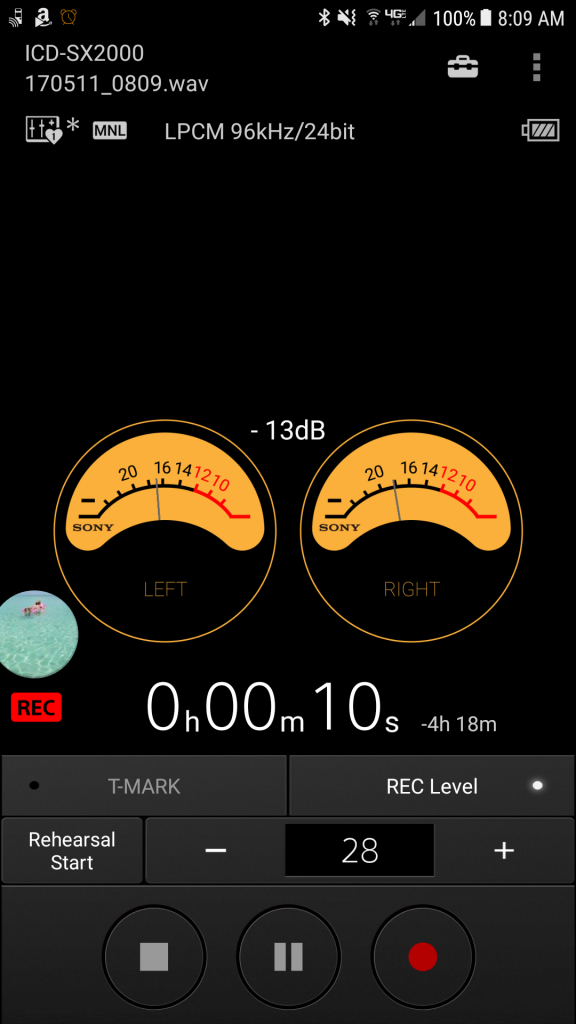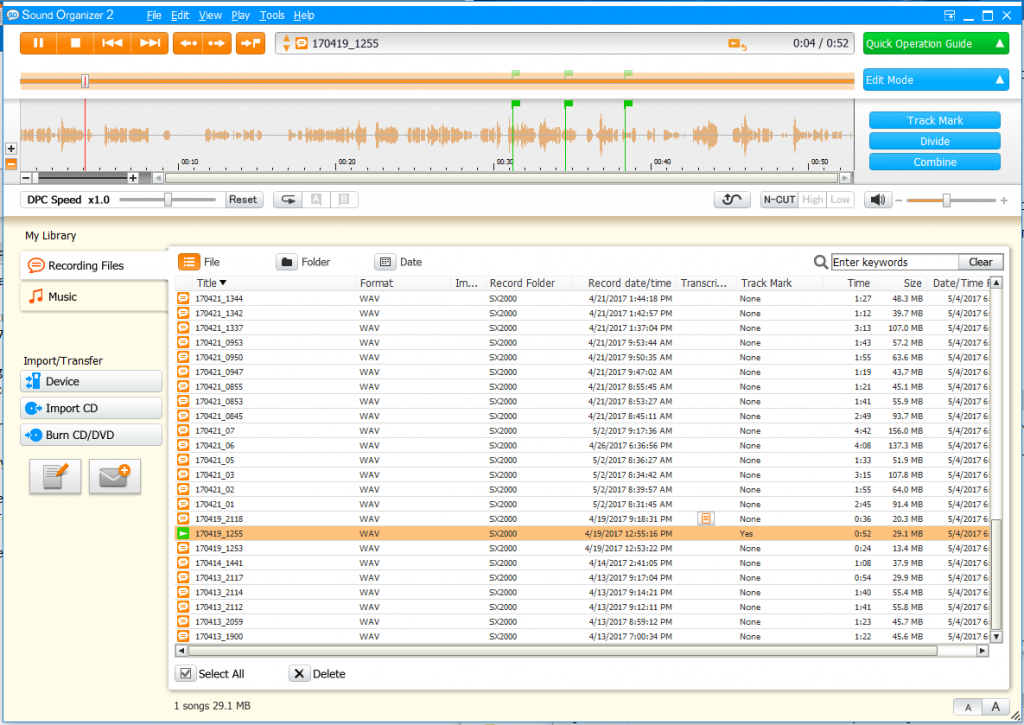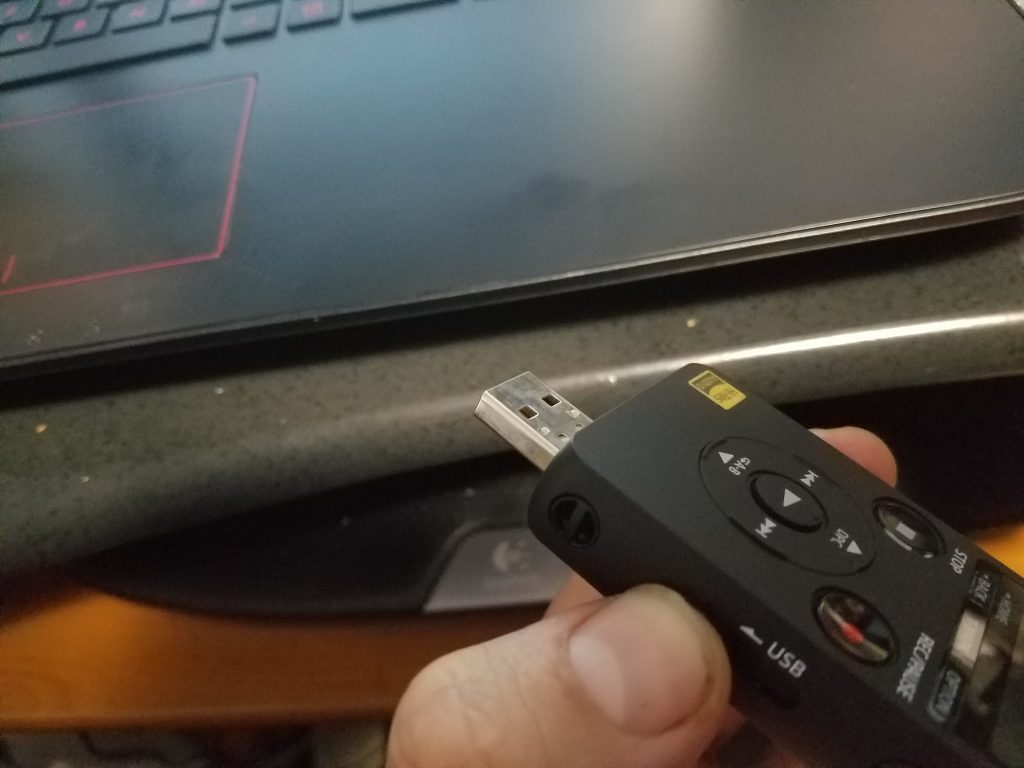
Audible tears were heard slowly rolling down sound designer’s cheeks when Sony discontinued both their M10 and D50 field recording models recently. They were affordable recorders with built-in mics that also offered plug-in power for attaching microphones with an 1/8” connection or a preamp for XLR mics. The recorders were well regarded for their small footprint, decent cost, and good quality. Sony has attempted to fill the void left from the departure of these two economical field recording mainstays with the ICD-SX2000, a very small footprint, high resolution audio recorder.
The first thing to strike you about the SX2000 is its size. It has the form (and model number) of a voice recorder, measuring a trim 1½ by 4½ inches. All the standard controls are there and the menus are simple to navigate and fairly intuitive. Many of the features and controls mirror either the D50, the M10 or both. Like the D50, it has dual microphone capsules which swivel into one of three positions: ORTF/120 degrees/wide, straight ahead and X/Y. The microphones are spaced less than an inch apart, so there is not a tremendously detectable difference across the three patterns. The mic capsules are also so tiny that when rotating them, they don’t feel particularly durable, but I had no troubles with them during testing.
The SX2000 dubs itself a Hi-Res Audio recorder, which essentially means it offers the ability to record at 96kHz/24-bit PCM. Beyond that, its choices are surprisingly limited, offering only 44.1/16-bit PCM and four MP3 quality settings ranging from 48kbps to 320. Why a recorder in 2017 chooses to record at 44.1kHz instead of 48k is an odd inclusion/omission.
The device has an impressive 16gb of internal memory, enough for 6+ hours of 96k recording, and also features a slot for a micro SD card on its side. It’s an impressive upgrade from the D50 and M10 which both offered similar features, but limited the built-in memory to just 4gb. (The D50 was further hobbled by only offering Sony’s proprietary MemoryStick as an additional memory slot, while the M10 allowed for both MemoryStick and SD card).
The battery is exceptionally robust. Over a three-day weekend full of recording the battery meter never dipped below it’s full bars display. On a soak test to determine how long the recorder could go before draining the battery, it recorded for five and a half hours nonstop before it dropped a single bar of its four bar battery display. Sony claims up to 15 hours recording on a single charge at 96/24 and I was seeing an admirably close figure of 12 – 14 hours. So without an extra SD card in the device, the SX2000’s memory fills up twice over before the battery drains once! The battery is a built-in lithium-ion, and can be charged via the included USB port (more on that below).
When recording, the device itself offers a small red peak indicator on the front just above the screen, which can get blocked when utilizing the included foam windscreen. The SX2000 also offers no additional -12dB lights as the M10 and D50 both had. It’s a minor gripe, but the -12 lights were a handy visual indicator on these past recorders.
Due to its small size and plastic body, the recorder is very prone to handling noise. Fortunately it also has some wonderful, modern features to alleviate the need to touch or even be near your recorder when operating it.


The SX2000 features bluetooth and an app available on both Android and iOS called REC Remote, which turns your phone into a fully fledged remote for the device. All features are available from the app including access to options settings, record, pause, dropping markers, setting record volume, viewing battery level as well as real-time waveform display and VU meters.
After the initial pairing between phone and recorder, the phone app was able to connect to the recorder in a matter of seconds. Smartphone app remote control is becoming the norm with companies like Zoom, Sound Devices, and Tascam offering similar tools for their newer recorders, and it’s a fantastic way to start/stop recording, adjust and monitor levels, etc. I was a little disappointed to find that you could not monitor the audio of your recording from the app via your phone’s headphone out. Perhaps it’s a latency issue with bluetooth, but it also reduces the usability of the remote app. However, unlike Zoom and Sound Devices, the app is available in both iOS and Android flavors.
It’s worth noting that one of the SX2000 many quirks make recording with the smartphone app a near necessity when using the device for field recording or recording sources with potentially variable levels. On the device itself are volume controls. When playing or recording, these controls only affect the headphone monitor levels. To adjust the recording level, you need to pause your recording and then adjust recording levels with the volume buttons. On the smartphone app, the volume controls only affect the recording level since the phone does not handle monitoring itself. The volume can also only be adjusted incrementally; by pressing and holding the + or – button it steps from 0 to 30, since the volume dial from the M10 and D50 has been eliminated.
As mentioned earlier, the recorder is the size of a handheld voice recorder and bears similar model number and layout to its digital voice recorder cousins, and some of its recording functions are customized specifically for interview style recording. Beyond traditional markers, there are also special markers the user can set such as “Question,” “Important,” and “New Topic.” It would be nice to allow these special markers to be customized for use in other disciplines and areas, but this does not seem available in the current version of the firmware.

The device also comes with software nestled inconsequentially onto its internal memory. It’s called SoundOrganizer 2 and it’s a Windows only application which can be used to transfer audio to and from the device, playback recordings, do minor edits, burn to DVD, and even transcribe interviews. Truthfully I found the software unnecessary bloatware. There is already plenty of sound organizing software on the market that has features more suited to general use and the SoundOrganizer software brought nothing exceptional to the expected feature set. Even worse, the software did not recognize any of the filename changes I made in Windows for the files from the SX2000 or the M10, only files from the D50 were imported with their descriptive filenames intact. It was also bizarre that only certain markers you can place from the SX2000 or REC Remote app show up in the display of SoundOrganizer as well.

The SX2000 has a built in retractable USB plug so you can pop it into any computer you like (either directly into your computer or via the included extension coupler if you need a little more space) and manage files directly from the recorder. I like the inclusion of the standard USB port because the USB protocol for plugs has changed so many times over the course of its lifetime from mini-USB (as featured in the M10 and D50) to micro-USB (on more current recorders) to the new USB-C form of plug. With the SX2000, you don’t need to carry around a special cord or hope you have a spare one lying around; instead you can just plug it directly into any open USB port on your computer.
That covers most of the features of the recorder itself, but what about the most important question: How does it sound? As this recorder is considered by many as a replacement for the M10 and D50, I decided to do comparison recordings between the three devices using both the built-in microphones and also a Roland CM-10 binaural mic via the external mic input. I recorded an array of natural ambiences, some interview style talking in a few different environments, and some sounds recorded in a dead production studio.
For its diminutive size and reasonable price point (~$230 street), it performed fairly well in most environments. It feels like it really wants to be a voice recorder, with the shape, layout and markers options, and it did a good job picking up voices clearly. Background noise, unfortunately, is always audible. In fact the built-in mics seem to have a noise floor at a whopping -44dB when recorded at full gain in a treated room, which was rather surprising. But when recording louder sounds in a relatively quiet environment, I found it easy to clean up the recordings eliminating most noise artifacts. But the SX2000 also showed a distinct lack of low-end presence that featured well in the D50 and M10. In fact I found myself rolling off the lows at 100Hz on some of my ambient recordings for the D50 and M10 to try and match parity with the SX2000, but still found the other recordings with more detail across the frequency spectrum. Below is a playlist of completely unprocessed files comparing the three recorders (each recording is sequenced: SX2000, M10, D50). The M10 and D50 come across as noisier recordings in the exterior settings due to the lack of low end in the SX2000 which is greatly alleviated with the aforementioned low end rolloff, but I wanted to provide a completely unprocessed comparison. The gong hits recorded in a professional studio demonstrate the noise floor on the SX2000 pretty well.
[soundcloud url=”https://api.soundcloud.com/playlists/321674578″ params=”auto_play=false&hide_related=true&show_comments=true&show_user=false&show_reposts=false&visual=true” width=”100%” height=”300″ iframe=”true” /]
The binaural recordings came across as fairly transparent and brought up another nice feature the SX2000 offers in comparison to its older brothers: once configured, when you plug in a microphone into the 1/8” port, it automatically detects the need for plug-in power. On the M10 and D50, when you plug something in, it asks if you want to use plug-in power, thereby necessitating an additional button press before recording. On the negative side of this, when I plugged a SoundDevices MixPre into the plug-in power port it detected it as a mic, not a line level source, so I had to go into the menu and change the input setting from MIC IN to Audio IN. This departure from accepted terminology (LINE IN = Audio IN) is one of several examples that suggest the device is more intended for non-professionals. The device also uses a template of saved options called scenes, so users can easily call one of these up to fall back onto presets if they wish to record, say a lecture, an interview, or a rock band. It’s a handy shortcut when you don’t understand where all the options are nested or what they mean or you want to create some custom recording settings and have them recalled with just a few menu clicks.
The SX2000 is commendable for its exceptionally compact size, ample built-in storage, and outstanding battery life. It could be a sufficient prosumer choice for recording interviews and podcasts, but for serious field recording the preamps are a bit too noisy and the frequency response not quite sensitive enough to consider using without having some additional high-quality mic preamps before the recorder or resigning yourself to some serious cleanup. As a pedigree of the M10 and D50, the SX2000 misses a lot of marks, but also introduces some nice new features. A lot of great field recordings have come from M10, D50 and D100s with a MixPre or other high-quality mic preamp attached, and the SX2000 definitely sounded best in a similar situation. If you’re in the market for a tiny recorder and you’ve got the additional gear to make it sound decent, it could be worth checking out.

Why Sony? Why?
Its too noisy and too expensive.
Very nice write up, Bradley.
I think it’s interesting how the point of view can influence a review. I was thrilled to discover (and don’t know why I haven’t until now, fully a year later, because I have looked, even at Sony’s site) that there has been a replacement for my beautiful SX1000 that I have been carrying on my person for several years now.
To me, a guy who basically records my entire life, just beacuse… this is a major leap forward (Bluetooth and cell phone control, for example). I would NEVER have considered this some kind of replacement for those field recorders, because it IS a voice recorder.
I’m surprised you made that connection, actually. Their voice recorders have been around, gradually improving in quality and features, since at least the early 2000’s. In January of 2001, I bought my first ICD-MS1 (which was mono) as a replacement for my microcassette recorder. That was followed by the ICD-BM1, which was more of a medical dictation device and even came with Dragon voice recognition software, the ICD-MX20 (a venerable device and the first stereo one!), the ICD-SX750 (that one didn’t last long), and I’ve been using the SX1000 since then. This was the first one to have a built-in rechargeable battery. All the previous ones took regular AAA batteries. For years I kept 15-minute rechargeable batteries and charged them every single day to keep the recorders running. Now, I just plug the SX1000 into my computer every night (that’s the one downside, you can’t just put fresh batteries in it, but you CAN plug it into a small USB backup charger, so it’s not all bad).
I wear these propped inside the hem of my pants on the left side with the mics out, face-in to preserve directionality. My friends all know I am recording my life 24/7 and lean over and speak into the recorder sometimes. I call it “Digital Buddy” because it means I can talk to myself without being completely insane because it’s being recorded… by my digital buddy, who is always listening. The way I relate to it, I’m talking to some listener 500 years from now who will get to hear the daily goings-on of a 20th-/21st-century geek.
This all evolved out of a desire to leave more than a hyphen between two dates on my tombstone. I want future grave-site visitors to be able to call up audio from any day of my life since the late 1990’s, which is what I have recorded. Yes, I have well over 20 years of my daily life recorded! Crazy, right??? :-)
So the review is somewhat off in that this was never intended to be a replacement for field recorders. It is yet the latest iteration of a LONG line of voice recorders… a damn good one that CAN be pressed into service as a field recorder in a pinch! I use it to record live bands, choirs, jet engines… you name it. It can handle it all. I’ve never been concerned about noise floor because it’s just my daily recorder… NOT a proper field recorder. You can even plug it into a mixing board and get dead-solid sound! It’s great B-roll audio, I’ll give you that!!
That being said… I’m about to buy one. I still can’t believe I didn’t know it was out. Are you sure about the plastic? My SX1000 is aluminum and looks like brushed aluminum in places instead of black-painted aluminum because of how I wear it under a belt every day for years.
These things are VERY durable, too. I can’t tell you how many times I have dropped this onto concrete and it keeps going with amazing audio! The one serious issue I have with these that has changed in recent years… they don’t do well when it gets TOO hot and sweaty. They will shut off sometimes in the middle of recording and then you will have lost everything since the last time you started recording. NOT COOL!!! I don’t know why they can’t fix that. I’ve complained about it enough. Why should you lose everything just because it powered off while recording??? It should still be there, right? But then that same thing can happen with hard drive multi-track recorders when they lose power, too, so who knows??? Surely the audio industry can figure out a solution to that, right? That’s one area where TAPE kicks solid state digital recording’s a$$!!!!
Also, it used to be that you could just hit a button to start a new file, and that was how I defended against losing data in the event of a shutoff… just hit that button every now and then when it was hot (I roller skate!) and you start a new file. Now you have to turn stop and start recording again to get a new file. They let you place markers, but NOT new files!!!! What a stupid thing to do!
Anyway, I could go on forever. I’m digressing here. The point is, these little recorders totally kick A$$, but don’t compare them to proper field recorders. That’s never been their intended purpose, though they CAN be used that way where noise floor isn’t your primary concern.
To Mark C. Lowe : Wow ! It’s quite surprising to find someone as crazy as myself in that field, and bold enough to admit it publicly, to justify it even ! :^p I thought that it was some kind of OCD-like disorder, akin to how the Jack Nicholson character is presented in the movie “As good as it gets”… Maybe it is, but hey, in this fucked-up world, at least it’s an inocuous way of being crazy ! :^p So, I feel the same imperious need to record pretty much everything, “just because” — to keep traces of the all-too-fleeting peculiar things that can be heard in that hectic world of ours, little everyday things that won’t be talked about in the news but are still worth remembering more than the last killing spree or any bullshit the government says… But I don’t believe that it could actually be of interest for someone someday, precisely because everything gets obsolete so fast nowadays, and there’s just too much information floating around for a normal human being to get interested in the little intricacies of one particular person who lived 60 minutes ago, let alone 60 years. (Recently I was flabbergasted to discover right at the next corner to my appartment, in south France, many boxes full of patiently organized pictures and writings, being put there, it would seem, after a man died, and waiting for the trash truck. Not even one person from that man’s entourage felt enough curiosity and affective attachment to go through those boxes and try to figure out the secrets of his inner life, make his passion and dedication count for something after his last breath… (For what I could see he went to China, was interested in genealogy, took saloon dancing lessons…) I took as much as I could, and now I don’t know what to do with it ! :^p And maybe some day someone will bring all this, as well as my own patiently organized stuff, to a street’s corner, waiting for a trash truck… And since I’m no Citizen Kane nobody will care whatsoever about my “Rosebuds”, or his, or yours, I’m sorry to say. And 500 years from now, humans could very well have to face really tough challenges just to not go extinct, so the musings of early 21st century geeks may very well make them cringe a little bit ! :^p)
I use a Yamaha C24, which is probably the tiniest decent quality recorder there is, even smaller than this one, and it gets about 24 hours of continuous MP3 recording with just one AAA battery. I thought that this new Sony recorder could be a higher quality replacement, with a similar form factor and the advantage of selectable stereo mic pattern, but from the audio samples I’ve heard so far I’m not impressed, it sounds stangely muffled, unnatural.
https://www.youtube.com/watch?v=4XI3maSTDHM
As for recordings disappearing when the power goes out unexpectedly : with my Yamaha C24 it happened a few times, for WAV recordings they just stayed there as idle space (when checking the Properties of the volume, the free space is less than what it should be, the difference corresponding to the “ghost” recording), just making a CHKDSK on Windows’ CMD command prompt would allow to recover them (in a hidden folder called FOUND.000). For MP3 recordings it’s trickier : if the recording is not finalized it remains considered as free space, and gets overwritten as soon as you record something else, but, if you know your ways with an hexadecimal editor it’s possible to get it back if you do it right away. I can’t explain the process here in depth, and it might differ slightly with another recorder, but you might find a tutorial somewhere. I gave detailed explanations on this forum thread, but it’s in french (pseudonym “idiosyncrazy”) :
https://fr.audiofanzine.com/enregistreur-poche/zoom/H4/forums/t.358653,recuperer-fichier-mp3-quot-0-octet-quot,p.2.html
(By the way the Zoom H2n has a built-in data recovery function for those situations.)
To Mark C; Lowe and Gabriel both: you are awesome.
I think that’s the best way to live a life, but unfortunately I don’t do it for I’m too conflicted with myself and trying to figure out the goals of this long walk =).
I admire how you are so stubbornly recording your entire lives. I reckon it can really give so much useful information that you’ve missed during the intial encounter.
Kudos to you both.
Great review thank you!
This recorder has now been discontinued and as of late 2018 now rebranded as the PCM-A10.